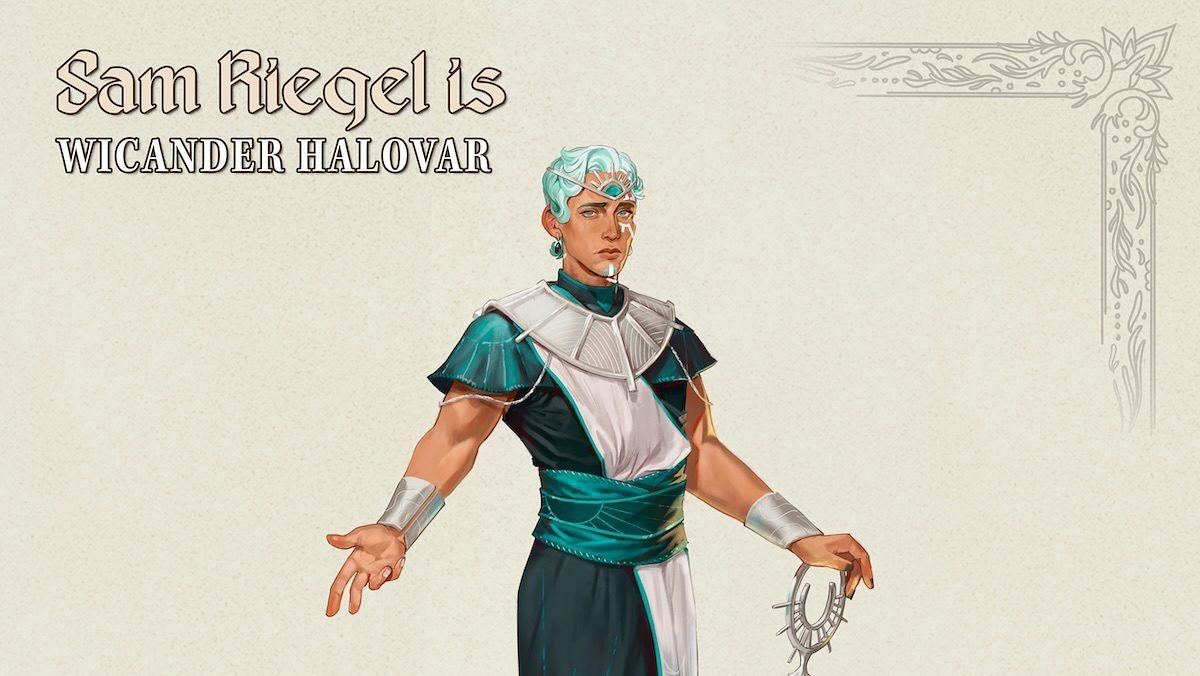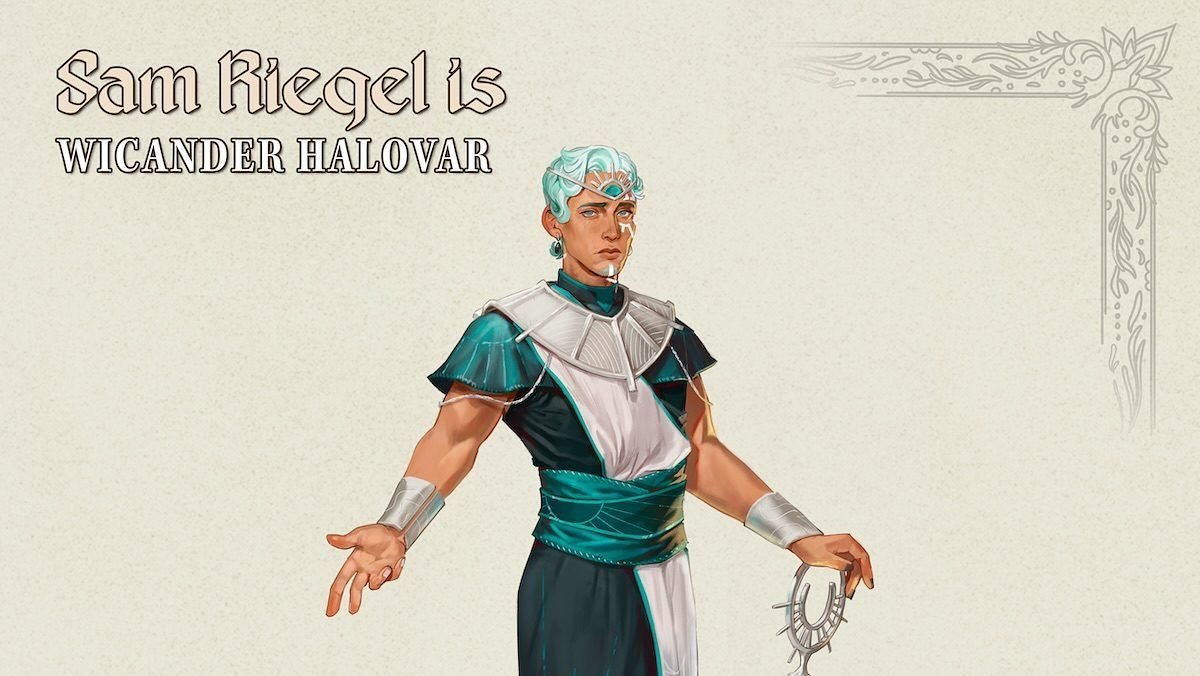Sam Riegel’s new character appears to be hiding a big secret in Critical Role’s new campaign, and his character stats provide a strong hint as to some subterfuge behind the scenes. Last week, Critical Role fans were first introduced to Wicander Halovar, a scion of the powerful House Halovar. Wicander (or Wick for short) is a priest of the Candescent Creed, a newly formed religion that’s gained in prominence after the gods of Adamar were killed 70 years before the start of the series.
Unlike other religions typically found in D&D games, the Candescent Creed doesn’t worship a specific diety. Rather they profess that the Light of the universe is a source of salvation, with various moral beliefs aligned with belief in said Light. According to the Candescent Creed, souls rejoin the Light when they die.
While the Candescent Creed seems to have gained some significant influence in Dol-Makjar, there are some not-so-subtle hints that there’s something nefarious at play with this religion. For one, the Candescent Creed consorts with demons, bringing them to the Material Plane of existence and attempting to “redeem” them by teaching them about the Light.
There’s also a level of suspicion that House Halovar established the Candescent Creed on their own, without the visible guidance of any god. As implied by NPC Aranessa Royce, House Halovar can use the Candescent Creed to manipulate the populace by passing off their beliefs as the beliefs of their religion.
Another sign that something is amiss with the Candescent Creed is Wicander Halovar, the player character of Sam Riegel. Wicander is a Light Priest of the Candescent Creed and spends much of the first episode quoting scripture and explaining the beliefs of his religion. Critical Role bills Wicander as a Cleric, but his stats tell a different story.
How Wicander’s Stats Suggest That He’s Perhaps NOT a Cleric (and Maybe a Soul Sorcerer) in Critical Role Campaign 4
In D&D, the Cleric is a Wisdom-based caster, meaning that the Cleric’s spells are directly empowered by the strength of their Wisdom score. However, Wicander’s Wisdom score is very average – his Wisdom score is only a 10. In fact, Wicander’s Wisdom score is tied for his lowest stat, meaning that Sam seems to be playing a very sub-optimal Cleric.
However, as is almost always the case with one of Sam’s characters, there’s probably more to Wicander than meets the eyes. Wicander’s highest stat is Charisma, with an 18. There are four Charisma-based classes in D&D 5E—the Bard, the Paladin, the Sorcerer, and the Warlock. It feels much more likely that Sam is one of those character classes, with Wicander posing as a Cleric to hide some deeper secret.

As there are multiple Paladins and multiple Warlocks in this campaign already, it’s likely that Wicander is either a Sorcerer or a Bard. There’s a specific Sorcerer subclass that derives their power from divine roots—the Divine Soul Sorcerer. According to established D&D lore, the Divine Soul Sorcerer has some familial connection to a divine being of some kind or acts as a vessel of divine magic as a servant of the gods. Not surprisingly, a popular theory among Critical Role fans is that Wicander is a Divine Soul Sorcerer either posing as a Cleric or genuinely believing that he actually is a Cleric.
Why Would Wick Pretend to be a Cleric?
So why would Wicander be posing as a Cleric? The likely answer is tied to the Candescent Creed and its origins. Thanks to some pre-campaign information provided by Brennan Lee Mulligan and Matt Mercer, we know that the gods were killed at the end of a long bloody war between those who worshipped the gods and those who rebelled against them.
Magic fundamentally changed as a result of the gods’ death. Long range teleportation has become much more risky and souls are no longer sent to the afterlife after death. What we don’t know is how involved the gods were on the Material Plane, such as whether they had any demigod offspring or celestial servants such as solars or planetars.
The easiest explanation is that Wicander possesses some kind of innate divine power and is hiding it behind the guise of being a cleric. Wicander’s divine powers would go a long way in establishing legitimacy of the Candescent Creed, while also protecting Wicander and his family from their ties to true divinity. House Halovar is one of the five Sundered Houses who seemed to come to power after the gods were killed during the Shapers War. So it would be particularly interesting if they had some kind of residual link to the very gods they had a role in killing.
There’s precedent for Critical Role hiding a character’s true class from viewers during their first introduction. Chetney posed as a Rogue during his initial appearances before his true class as a Blood Hunter. In that case, the subterfuge was meant to hide Chetney’s true nature as a lycanthrope, although many fans had sussed out this secret based on inconsistencies in Chetney’s stats and mannerisms compared to that of a Rogue.
Whatever the reason, it’s very clear that Sam Riegel is hiding some sort of secret when it comes to Wicander Halovar. This, of course, is excellent news as Riegel has a tendency of expertly teasing out his characters’ secrets via top-notch storytelling. Considering that Wicander appears to be a devout believer of the Candescent Creed, it would be interesting for him to find out that his religion is nothing more than an empty lie designed to keep the populace under control.
Of course, at this point in time in the new campaign, it’s hard to say what direction this wrinkle will go, so Critical Role fans should just keep an eye on Wicander and enjoy whatever direction his story goes.
The post Has Sam Riegel Hidden a Twist in His CRITICAL ROLE Campaign 4 Character Wicander Halovar? appeared first on Nerdist.
This articles is written by : Nermeen Nabil Khear Abdelmalak
All rights reserved to : USAGOLDMIES . www.usagoldmines.com
You can Enjoy surfing our website categories and read more content in many fields you may like .
Why USAGoldMines ?
USAGoldMines is a comprehensive website offering the latest in financial, crypto, and technical news. With specialized sections for each category, it provides readers with up-to-date market insights, investment trends, and technological advancements, making it a valuable resource for investors and enthusiasts in the fast-paced financial world.
